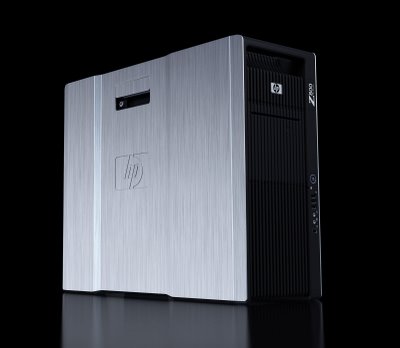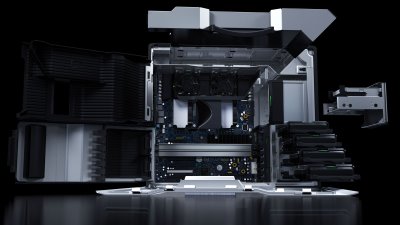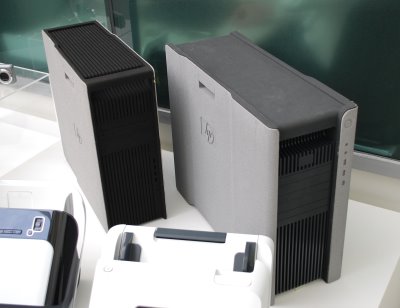#4: It’s been a frustrating few days for me. Not only because I had to leave sunny LA at the tail end of last week to return to wind and rain in London, but I got to see all manner of exciting technologies at HP’s global workstation event, which I’ve been unable to write about until now due to embargo restrictions.
One of these technologies is HP’s brand new workstation family, the Z Series (pronounced Zee Series by those the other side of the Atlantic). Comprising three models – the Z400, Z600 and Z800 – the new machines are something to get quite excited about. This is not just because of Intel’s new, incredibly powerful Xeon 5500 series processors, but because HP has completely re-thought the workstation and the way it can be serviced, upgraded and generally taken to bits.
To my mind, only Apple and Sun have delivered similar levels of serviceability offered by HP’s new Z series, which is completely tool-less in design. For its demonstrations, HP focussed on its top-end Z800 showing exactly how easy it is to service and maintain.
HP’s New Z800 workstation, can be taken to bits in minutes – and look, no wires!
The whole system relies on clearly marked green levers and clips to give users visual clues as to how to take things apart. HP has done this before but never to this level of simplicity. First of all there are no wires inside the machine! These are all routed behind the back of the motherboard – not only to make things easier, but not to interfere with the CFD-optimised airflow throughout the machine. Even the dongles used to power high-end graphics cards, such as the Quadro FX 5800, are routed behind the motherboard and neatly clipped away when not in use.
Everything in the system, from graphics cards to hard drives and even motherboard, feature innovative mechanisms for easy and tool-less removal. Components that rely on power, such as the power supply and memory fans, use blind mate connectors, which are funnel-shaped to guide the components into place.
The power supply itself has been completely redesigned, and runs the whole length of the chassis so it can take in cool air from the front of the machine and as a result generate less fan noise. User maintenance and diagnosis has also been improved and should the workstation develop a power problem the supply unit can be removed simply by pulling it out by its handle. Then plugging it into the mains will help the user verify the cause of the problem. If the supply is indeed faulty the green light on the side of the unit will not come on. HP will then ship out a replacement power supply which can be easily installed by the user.
In its quest for even quieter machines HP has also innovated in its cooling mechanisms. Specially designed injection moulded ducting means each CPU in a dual socket machine receives fresh air from the front of the workstation reducing the load and improving acoustics. Dedicated fans for each memory bank also run independently from each other to minimise noise.
For those craving even fewer decibels, a liquid cooling option will also be available this summer and new Intel solid state hard drives, which not only run quieter than traditional physical drives, but consume less power and produce less heat, will also be introduced soon. These will also increase performance for those that access a lot of data, frequently.
Power saving
HP made some bold statements about power, claiming that on average its new workstations consume 35% less power than similarly configured machines in its previous generation. In terms of power efficiency, all of its power supplies now surpass the 80plus initiative and are now 85% efficient. The redesigned 1,100W unit in the Z800 is even 89% efficient.
HP has also done a lot of work on power saving and a new hibernate mode called HP WattSaver reduces power consumption to 0.8W, compared to the 2.1W in its previous generation workstations.
In addition, HP claims that all HP workstations are to 90% recyclable by weight and the HP Z line is registered as Electronics Products Environmental Assessment Tool (EPEAT) Gold, the highest rating available.
DesignWorks was instrumental in the development of the innovative new chassis for HP’s new Z Series workstation. Foam protoytpes pictured.
Industrial Design
HP engaged BMW DesignWorks as part of its industrial design team and to do the global customer research into what its customers want from workstations. In addition to the totally tool-less design to transform the way users re-configure systems, the Z600 and Z800 feature integrated handles making it easier to move them around on site. Also, because the workstations don’t have rubber feet, they can be slid around on carpets and tiled floors.
Styling was also high on the agenda and the ‘design language’ developed by DesignWorks expresses clean lines and premium materials. The grill that runs down the entire front of the Z600 and Z800 was made possible by incorporating a slot loading optical drive and brushed aluminium side panels also feature. Finally, with its injection moulded components, the machine also looks elegant from the inside, as opposed to the usual mess of wires and clips. It’s a welcome change from HP’s ‘xw’ chassis, which was getting a bit long in the tooth and while the Z Series has a refined look, it’s still no Mac Pro in terms of character.
Alec Bernstein, Senior Director, Strategy, Research & Strategic Partnering, DesignWorks USA, also explained how the Z800 applies a lot of the principles of green design. For example, minimizing the amount of screws and fasteners can have a huge impact on the environment as screws travel more than any product in the world as they are mined, manufactured and then shipped globally.
The Z family
HP’s new Z workstation series feature three models, the Z800, Z600 and Z400. The entire family is based around Intel’s new Xeon processor 5500 and 3500 series (codenamed Nehalem), which feature integrated memory controllers and Turbo Boost Technology.
The Z400 is a single socket machine taking the price/performance position in the range (though HP will continue to produce its Core 2 Duo-based xw4600 for those that want an even lower entry-point). The Z600 is a compact dual socket workstation, but for ultimate expandability the Z800 offers up to 192GB memory and 7.5TB of internal storage.
All workstations are armed with 1,333MHz DDR-3 memory and new professional graphics solutions have been introduced across the line. These include Nvidia’s Quadro FX380, FX580, FX1800, and FX3800, which join the established FX4800, and FX5800 in the high-end machines. The choice of AMD graphics cards has also been expanded over previous generation workstation families with the ATI FirePro V3700, V5700 and V7750 all offered as standard options.
Conclusion
With the introduction of the new Xeon 5500 Series, it’s an exciting time for workstations in general, because performance is about to go through the roof, particularly when users are multitasking or running multithreaded applications.
However, while this level of performance will be seen across new product introductions from all the major workstation vendors, what makes HP stand out from the crowd at this moment in time is its innovative approach to chassis design, which looks set to make the servicing of workstation an absolute breeze. Check back in the coming months where we plan to get our hands dirty with full reviews of the systems.









